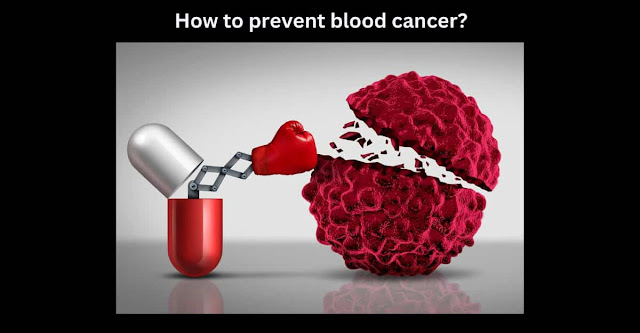Blood Cancer: Leukemia, Lymphoma, and Myeloma
Understanding the Different Types of Blood Cancer:
Leukemia, Lymphoma, and
Myeloma
1. What is blood cancer?
2. What are the symptoms of blood cancer?
3. Types of blood cancer
4. Treatment of blood cancer
5. Is blood cancer hereditary?
6. How to prevent blood cancer?
Blood cancer is a devastating disease that affects countless individuals and families around the world. It is difficult to put into words how much of an impact a diagnosis of blood cancer can have on someone's life. The shock, fear, and uncertainty that comes with such a diagnosis can be overwhelming for both the patient and their loved ones. In this article, let's learn more about blood cancer.
What is blood cancer?
Blood cancer, also known as hematological cancer, is an umbrella term that
refers to cancer that develops in the blood, bone marrow, or lymphatic system.
It affects the production and function of blood cells, resulting in an abnormal
increase in the number of cancer cells. These cancer cells can be divided into
three main types: leukemia, lymphoma, and myeloma.
What are the symptoms of blood cancer?
There are different types of blood cancer, each with its own symptoms.
However, some of the most common symptoms of blood cancer include:
Fatigue and weakness
Recurrent infections or fever
Unusual weight loss
Night sweats
Bone or joint pain
Swollen lymph nodes, especially in the neck, armpits, or groin
Easily bruising or bleeding, such as nosebleeds or bleeding gums
Shortness of breath
Dizziness or lightheadedness
Loss of appetite
These symptoms can also be caused by other conditions, and having one or
more of these symptoms does not necessarily mean that someone has blood cancer.
However, if someone experiences any of these symptoms, it is recommended to
consult a doctor for an accurate diagnosis and appropriate treatment.
Types of Blood Cancer
Leukemia
Leukemia is a complex and aggressive blood cancer that occurs when the body
produces abnormal white blood cells that are not fully developed and cannot
perform their intended functions. The overproduction of these immature cells
can disrupt the production of healthy red blood cells and platelets, which are
necessary for carrying oxygen and preventing bleeding, respectively. There are
four main types of leukemia:
Acute myeloid leukemia (AML)
Acute lymphoblastic leukemia (ALL)
Chronic myeloid leukemia (CML)
Chronic lymphocytic leukemia (CLL)
Leukemia, a type of blood cancer, can manifest in a variety of symptoms.
Some common symptoms include fatigue, difficulty breathing, yellowing of the skin,
frequent infections, easy bruising or bleeding, swollen lymph nodes, and bone
pain. The onset of these symptoms can vary, as they may develop gradually or
appear suddenly, depending on the type of leukemia and the progression of the
disease.
Now one may wonder how leukemia is diagnosed? Leukemia can be diagnosed through various tests and procedures, including:
Blood tests:
Blood tests can help detect abnormal levels of white blood cells, red blood
cells, and platelets, which are often associated with leukemia.
Bone marrow biopsy:
This test involves removing a small sample of bone marrow from the hip
bone. The sample is then examined under a microscope to check for the presence
of leukemia cells.
Imaging tests:
Imaging tests such as
X-rays, CT scans, and MRI scans can help detect any abnormalities in the bones,
organs, or tissues.
Lumbar puncture:
Also known as a spinal
tap, this test involves removing a small amount of cerebrospinal fluid from the
spinal cord. The fluid is then examined for the presence of leukemia cells.
lymphoma
Lymphoma is a complex and serious blood cancer that attacks the lymphatic
system and the body's ability to fight harmful infections and diseases. This
type of cancer occurs when white blood cells, called lymphocytes, begin to behave
abnormally and grow uncontrollably. There are two main types of lymphoma:
Hodgkin's lymphoma and Non-Hodgkin's lymphoma, and each of these can be further
divided into subtypes depending on the specific type of lymphocyte affected.
Lymphoma can sometimes be asymptomatic in its early stages. However, some people may experience symptoms including enlarged lymph nodes, fatigue, night sweats, weight loss, fever, and itching.
So, can lymphoma with such a complication be treated?
The prognosis for lymphoma depends on the type and stage of the cancer.
Hodgkin's lymphoma has a very high cure rate, with up to 90% of patients
achieving long-term remission. Non-Hodgkin's lymphoma is a more diverse group
of cancers with varying cure rates, but many cases can be successfully treated
with chemotherapy, radiation therapy, or stem cell transplantation.
Myeloma
Myeloma is a rare type of cancer, and it usually affects people over the
age of 60. It is a type of blood cancer that affects plasma cells in the bone
marrow. Plasma cells are responsible for producing antibodies that help fight
infection. Myeloma cells produce abnormal proteins that can damage the bones,
kidneys, and other organs.
Symptoms of myeloma can vary depending on the stage and severity of the
cancer. Some common symptoms include bone pain, especially in the back, ribs,
and hips, fatigue, frequent infections, easy bruising and bleeding, unexplained
weight loss, increased thirst and urination, nausea and vomiting, constipation
or diarrhea, and confusion and memory loss.
Blood Cancer Treatment
Now the question arises, is blood cancer curable? Treatment for blood
cancer varies depending on the type and stage of the cancer, the patient's age
and overall health, and other factors. The main treatment options for blood
cancer include:
Chemotherapy:
This is a common treatment for blood cancer. It involves the
use of drugs to kill cancer cells. Chemotherapy drugs are usually given
intravenously or orally.
This uses high-energy radiation to kill cancer cells. It
can be delivered externally, where the radiation is directed at the cancerous
tumor from outside the body, or internally, where radioactive material is
placed inside the body near the cancerous tumor.
This is a type of treatment that boosts the immune system’s
ability to fight cancer. It involves using drugs that stimulate the immune
system to attack cancer cells.
This is a type of treatment that targets specific
proteins or genes that are involved in the growth and spread of cancer cells.
It involves using drugs that interfere with the signals that cancer cells need
to grow and divide.
This is a treatment that involves replacing a
patient’s diseased bone marrow with healthy stem cells. The healthy stem cells
can be obtained from the patient’s own body (autologous transplantation) or
from a donor (allogeneic transplantation).
In addition to these treatments, patients with blood
cancer may also receive supportive care to manage symptoms and side effects.
Supportive care may include pain management, anti-nausea medications, blood
transfusions, and antibiotics.
Treatment for blood cancer depends on a variety of factors, and may include
a combination of treatments such as chemotherapy, radiation therapy,
immunotherapy, targeted therapy, and stem cell transplantation.
Is blood cancer hereditary?
It can be worrying to know that some types of blood cancer can run in
families, but having a family history does not always mean that a person will
develop the disease. It is very important to understand the possible risk
factors for blood cancer and take proactive steps to reduce the risk of
developing it.
By maintaining a healthy lifestyle, getting vaccinated, and seeking prompt medical attention for infections, individuals can help protect their health and well-being. In addition, regular check-ups with a doctor can detect early signs of blood cancer, allowing for timely treatment and management.
How to prevent blood cancer?
It may be difficult to completely prevent blood cancer, but there are
several steps people can take to reduce their risk and promote overall health.
Here are some ways that may help prevent blood cancer.
Avoiding harmful chemicals: People who work in industries with exposure to
chemicals like benzene and formaldehyde should take precautions to limit their
exposure to these carcinogens.
Maintaining a healthy lifestyle: Eating a balanced diet, exercising regularly, and avoiding tobacco and excessive alcohol consumption can help reduce the risk of blood cancer.
Get vaccinated: Vaccines can prevent infections that increase the risk of blood cancer, such as hepatitis B and human papillomavirus (HPV).
Detect and treat infections: Chronic infections such as hepatitis C and HIV can increase the risk of blood cancer. Seeking prompt medical attention for infections can help reduce the risk.
Get regular checkups: Regular checkups with a doctor can detect early signs of blood cancer and other health conditions. Early detection and treatment can lead to better outcomes and a better quality of life.
By taking these proactive steps, individuals can help reduce their risk of
blood cancer and maintain their overall health and wellness.
Blood cancer is a complex and multifaceted disease that can affect the
blood, bone marrow, and lymphatic system, requiring personalized treatment
plans from treatment to supportive care. A diagnosis of blood cancer can be emotionally
overwhelming, but advances in medical research and treatment offer hope for
managing the condition and improving quality of life.
Along with medical care, it is important to provide emotional support and understanding to patients and their loved ones throughout their journey. By taking proactive steps, such as adopting a healthy lifestyle and treating infections promptly, we can reduce the chances of developing this complex disease. By working together to advance research, treatment, and prevention, we can increase our understanding of blood cancer and improve outcomes for those affected.












